NHAI Unveils First Road Sector Asset Monetization Strategy to Boost Investment
With this launch, NHAI has not only reaffirmed its commitment to financial innovation and infrastructure excellence, but also provided a template for other infrastructure ministries to emulate.

- Country:
- India
In a landmark step to unlock the economic potential of India’s vast road infrastructure and attract private sector participation, the National Highways Authority of India (NHAI) has officially released its first-ever ‘Asset Monetization Strategy for the Road Sector’. The strategy outlines a comprehensive roadmap for sustainable infrastructure financing, serving as a key milestone in the government’s vision to modernize and expand India’s National Highway network through innovative market-based mechanisms.
This pioneering initiative is a core component of the broader National Monetisation Pipeline (NMP), which aims to enhance the utilization of public infrastructure assets by leveraging private sector efficiency and financing.
Structured Framework to Mobilize Capital
The newly launched strategy presents a structured and detailed framework to monetize operational highway assets using three primary financial instruments:
-
Toll-Operate-Transfer (ToT) model
-
Infrastructure Investment Trusts (InvITs)
-
Asset-backed Securitisation
These tools are designed to unlock capital from operational assets, allowing reinvestment in new infrastructure projects and reducing reliance on budgetary allocations or traditional debt financing.
So far, NHAI has raised over ₹1.4 lakh crore across more than 6,100 km of National Highways using these monetization models, demonstrating the effectiveness and market confidence in its approach.
Three Core Pillars of the Strategy
The document is built around three foundational pillars that will guide all future monetization efforts:
-
Value Maximisation of Government Road Assets
-
Focus on asset identification, operational optimization, and investor alignment
-
Standardized evaluation to enhance asset bankability and revenue potential
-
-
Transparency and Investor Information Dissemination
-
Use of digital dashboards, data rooms, and online platforms
-
Real-time availability of project data, concession agreements, and bidding metrics
-
-
Market Development and Stakeholder Engagement
-
Broaden investor base across domestic and international markets
-
Encourage financial institutions, pension funds, sovereign wealth funds, and retail investors to participate
-
Promote co-development and long-term partnerships through open, competitive processes
-
Leadership Vision and Industry Confidence
Shri Santosh Kumar Yadav, Chairman of NHAI, underscored the strategic importance of the document at the launch:
“The unique approach that NHAI has adopted towards asset monetisation not only ensures financial sustainability but also opens opportunities for the private sector, leverage advanced technologies, enhance quality and longevity of our road assets. The successful implementation of this strategy will provide NHAI with a steady stream of financing, reducing our reliance on traditional funding sources.”
Adding to this, Shri N.R.V.V.M.K. Rajendra Kumar, Member (Finance), NHAI, said:
“This document outlines a strategic framework to maximise the benefits of asset monetisation. It emphasises the need for a structured approach to identify and value assets, ensuring transparency and fostering investor confidence.”
Their remarks reflect a shared vision of transforming the Indian road sector from a state-dependent infrastructure model to a financially autonomous and investor-friendly ecosystem.
Alignment with National Infrastructure Goals
The strategy is fully aligned with the Government of India’s Asset Monetisation Plan (2025–2030) and reflects a growing commitment to shift from a capex-heavy development model to one driven by financial innovation, asset optimization, and lifecycle cost efficiency.
This transition is pivotal for achieving the objectives of flagship infrastructure initiatives such as:
-
PM Gati Shakti – National Master Plan for Multi-modal Connectivity
-
Bharatmala Pariyojana – Phase II
-
National Infrastructure Pipeline (NIP)
By monetizing completed assets and rechanneling funds toward greenfield projects, the strategy provides a sustainable financing loop that ensures continued infrastructure growth without fiscal stress.
Investor Confidence and Future Outlook
As one of India’s earliest adopters of asset monetization in transport infrastructure, NHAI has established a proven track record. Its success in raising capital through ToT bundles, InvIT listings, and securitization of toll revenues has garnered interest from both domestic and global investors.
The Asset Monetization Strategy is expected to:
-
Standardize investor engagement through transparent bidding processes
-
Foster long-term partnerships with private players for O&M and asset upgradation
-
Catalyze innovation in toll collection, digital asset tracking, and lifecycle maintenance
-
Improve service delivery and road user experience across monetized highways
The full strategy document can be accessed on the official NHAI website: 🔗 Asset Monetization Strategy Document (PDF)
A Roadmap for Future-Ready Infrastructure
With this launch, NHAI has not only reaffirmed its commitment to financial innovation and infrastructure excellence, but also provided a template for other infrastructure ministries to emulate. The road sector’s transformation from a state-driven project model to a market-responsive investment ecosystem will be key to building a connected, competitive, and future-ready India.










